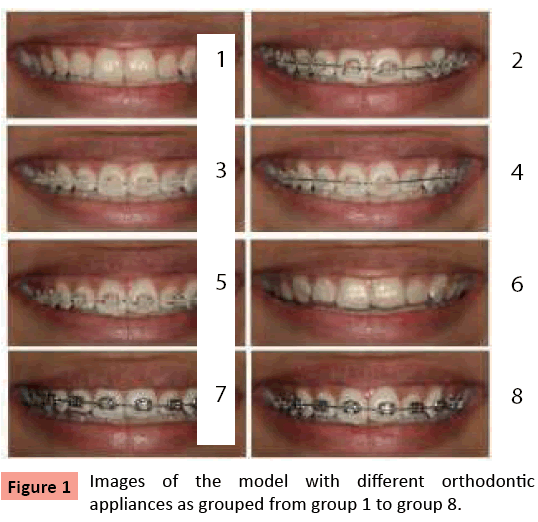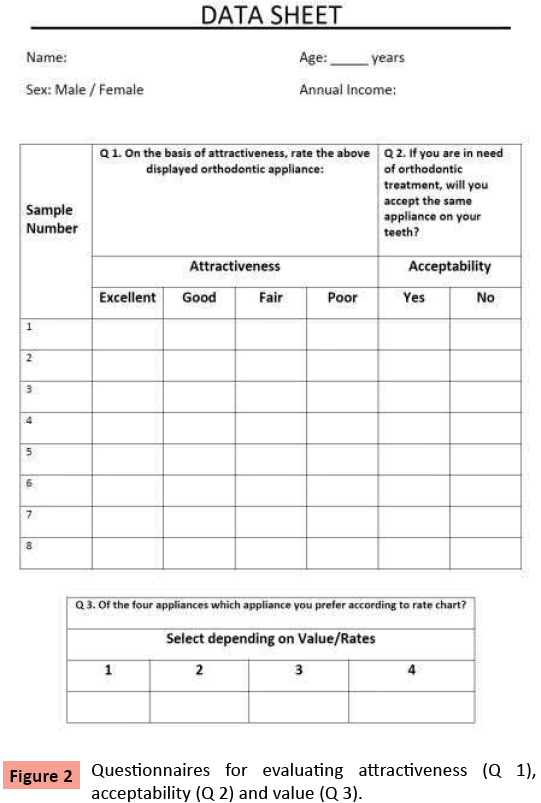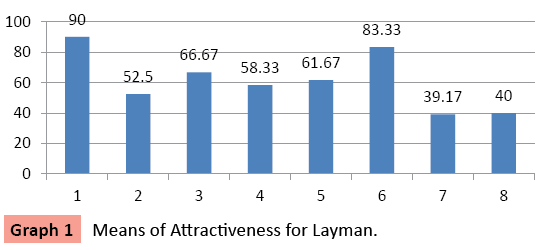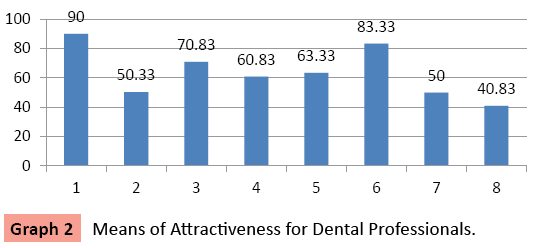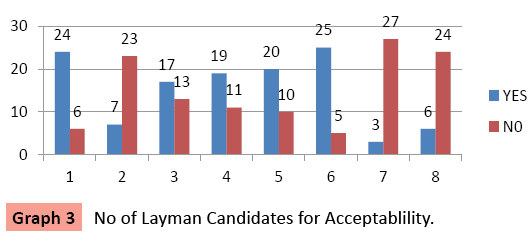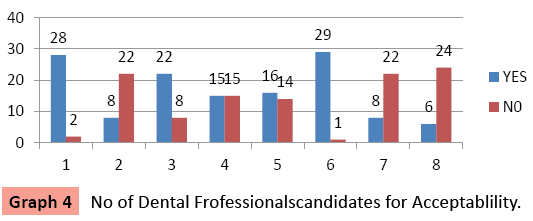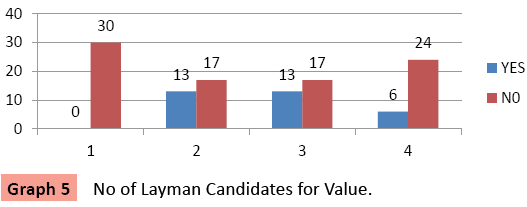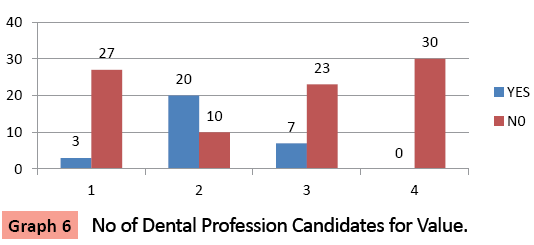Perception Of Dental Professionals And Laypersons To Appearance Of Orthodontic Appliances And Economic Values: A Questionnaire Study
Vaki Chinde, Abhishek Bansal, Ashok Talapaneni, Safiya Sana, Asma Fatima, Asiya Fatima, Arifa, Meenakshi and Dr. Laiq Sami
Deptartment of Orthodontics, Guardian Dental College and research Center, Ambernath, Mumbai, India
- *Corresponding Author:
- Dr. Abhishek Bansal
Senior Lecturer, Deptartment of Orthodontics
Vaidik Dental College and Research Center
Nani Daman, India
Tel: 9726779249
E-mail: ashi142002@yahoo.co.in
Abstract
Introduction Orthodontist’s practice in developing countries is influenced by dental professionals and patients, based on the aesthetics and cost of the appliance. Thereby a solution to it has to be found by selecting an appliance which fulfils the biomechanical, aesthetic and cost factor so that it is accepted by orthodontist, dental professionals and patients. Thereby the aim of the study was to determine the acceptability, attractiveness and treatment values of various orthodontic appliances among lay persons and dental professionals which would act as a guide for selection of appliance in developing countries. Method A questionnaire study was performed displaying the images of eight different orthodontic appliances which were employed on the model. The images were individually displayed to dental profession (n=30) and layperson (n=30) using simple random sampling. Comparative evaluation using appropriate statistical analysis was performed to rank appliances on the basis of attractiveness, acceptability and value. Results The results showed for both groups that as the metallic display raise an attractiveness and acceptability drop. The appliance of choice for both groups based on value is lingual appliance. Conclusion The most accepted appliance system taking in to consideration the patient and clinician in developing country is lingual appliance. Hence an orthodontist should excel themselves in lingual therapy so that the population desires are fulfilled to the best.
Introduction
Orthodontic speciality has travelled its path since Angle’s era [1] to the present one, ranging from obnoxious banded appliances [2] which lacked the three dimensional control over the tooth, to the present days bracket less approach [3,4].In the past, the choices for bracket style or appliance design were substantially limited for both the patient and clinician. At present the patients undergoing orthodontic treatment have a choice with a variety of orthodontic appliances ranging from traditional stainless steel appliance to ceramic, lingual and clear aligners [5].
Orthodontic market has thus experienced remarkable evolution in the development and creation of orthodontic appliances that are designed to appeal the patients. With the advent of newer technology like invention of CAD-CAM the brackets travelled its life from a bulky metal appliance, to aesthetic brackets (ceramics and plastic brackets) [6-8], lingual bracket systems [9,10] and finally bracket-less approach (Invisalign and Clear Path) [3,4]. This, although enhanced the aesthetic aspect, but lost its dexterity to the common man due the increasing treatment cost (Value). Because of these innovations in the aesthetic orthodontic appliances there is an increase in acceptability of adult orthodontics [11].
The new paradigm in diagnosis and treatment planning of dentofacial orthopaedics and orthodontics is aesthetics [12].It is in limelight even with appearance of orthodontic appliances. These orthodontic appliances have their own aesthetic assets and biomechanical benefits but they also carry potential limitations regarding price (Value). So it is beneficial for orthodontist to choose the orthodontic appliance which will be acceptable to patient and clinically resourceful to orthodontist.
With the increasing price and cost of living, a common middle class man in developing countries like India, also values for money. Thus along with the attractiveness and acceptability, a combined interest of patients for the treatment charges must be evaluated to assess the acceptable appliance system, which a patient can afford.
Few studies were conducted evaluating the attractiveness of orthodontic appliances. The results of the studies showed that adult patients desired less metal display in their orthodontic appliances and were less keen to accept treatment with appliances they consider to be unaesthetic [13,14].
Similarly, other study showed that 67% of Sweden young adults would probably not or definitely not wears visible appliances in spite of a functional treatment indication and there was also a refusal rate of 33% to conventional orthodontic treatment. Same study revealed that 84 % would definitely wear visible braces during adolescence [15]. Additional aspect is the social perceptions of adults wearing orthodontic appliances, since the judgments concerning their personal characteristics are influenced by dental appearance and orthodontic appliance design [16].
All of the studies were projecting the data from the western population. To our knowledge no study has been done in Indian population (developing countries) and no comparison has been done between the layperson and dental professionals. Thereby the aim of the study was to determine the acceptability, attractiveness and treatment values of various orthodontic appliances among lay persons and dental professionals taking into consideration rater’s age and socio-economic status.
Materials and Method
The study was planned to perform in Gulbarga, Karnataka. India.
Model selection
A model was chosen for application of appliances and clicking photographs on the basis of good alignment of teeth, adequate teeth and gingival show along with deficiency of strong sex markers in the circum-oral region.
Orthodontic appliances application
Metal (American orthodontist) and ceramic (ORMAER) brackets were temporary bonded on maxillary arch from second premolar to second premolar without etching the tooth surface along with the use of adhesive (Transbond XT bonding system, 3MUnitek) and LED light for curing. To simulate clear aligner a photograph was captured with a fabricated clear tray on orthodontic study models. Another image was taken without appliance to simulate lingual appliance. The wires used were 0.017” x 0.025” NiTi standard wire (Captain Orthodontics) and 0.017” x 0.025” NiTi tooth coloured (G and H Orthodontics). The ligation was performed using ligature wire and clear ties respectively.
Images were captured and grouped in to eight groups: (Figure 1)
• Group 1- no appliance i.e. lingual appliance.
• Group 2- ceramic brackets with standard wire and ligature ties.
• Group 3- ceramic brackets with tooth colour wire and clear ties.
• Group 4- ceramic brackets with standard wire and clear ties.
• Group 5- ceramic brackets with tooth colour wire and ligature ties.
• Group 6- clear aligners.
• Group 7- metal brackets with standard wires and ligature ties.
• Group 8- metal brackets with standard wires and clear ties.
Image capture and standardization
SLR camera (Canon EOS 400D) was used to capture digital images in the frontal smile view equipped with a 100 mm macro lens (Canon) and ring flash (Canon MR-14EX). All the images were captured at same shutter speed-(1/60), focal length (5.6) and ISO (1600) keeping the room lights off. The camera was fixed to a tripod and placed at a static distance in a straight line between the patient’s face and the camera lens. Camera settings were adjusted manually, and image enhancement features in camera were kept off to safeguard images reproducibility. In all eight images were captured with different orthodontic appliances and standardized using Photoshop (version 7.0 Adobe).
Sample selection
Simple random sampling method was used to select the samples. Samples were divided in to two groups:
• Group 1- Laypersons – 30 samples. (Final year students from PDA engineering college, Gulbarga, age range- 19-26 years)
• Group 2- Dental professionals - 30 samples. (Interns and final year students from Al-Badar dental college and hospital, Gulbarga, age range 21-26 years)
Sampling method
A questionnaire (Figure 2) was framed for evaluation of attractiveness, acceptability and value of orthodontic appliances as grouped from group 1 to group 8. It was distributed among the sample population and the images were displayed sequentially on the laptop (one at a time) to the two groups, and were asked to mark their views on all the three parameters. For assessment of value only four appliances were displayed and treatment cost was cited in front of images. The four appliances with their rates for assessment of value: clear aligners– Rs 1, 50,000, lingual- Rs 60,000, ceramic brackets- 30,000 and metal brackets- Rs 15,000.
Statistical analysis was done for the three parameters individually and between the two groups.
Statistical analysis
Attractiveness was evaluated using discrete data among eight groups. Thereby to evaluate the correlation between multiple groups for discrete data the applicable statistical analysis namely analysis of variance (ANOVA) was performed. Whereas the acceptability and value parameters falls under ordinal data thereby the appropriate statistical analysis namely Chi square test was used over the test groups for evaluating the association.
Similarly for the same reason comparison between the rating groups, i.e., layperson and dental profession for attractiveness was done using students ‘t’ test and for acceptability and value using chi square test.
Results
Attractiveness
F value for evaluating attractiveness among eight groups in lay persons and dental professionals were calculated as 24.16 (p=0.05) and 26.95 (p=0.05) which suggest a significant difference among the eight groups. The mean and standard deviation are shown in Table 1, Graph 1 and Table 2, Graph 2. The ranking of groups can be projected in descending order according to both the groups, which is as follows:
| Group 1 | Group 2 | Group 3 | Group 4 | Group 5 | Group 6 | Group 7 | Group 8 | |
|---|---|---|---|---|---|---|---|---|
| MEAN | 90.00 | 52.50 | 66.67 | 58.33 | 61.67 | 83.33 | 39.17 | 40.00 |
| SD | 13.84 | 19.74 | 20.75 | 18.63 | 20.14 | 25.28 | 22.06 | 18.93 |
| F VALUE | 24.16(>1.96 for P=0.05),There is Significant Difference | |||||||
Table 1: Mean and SD (Standard deviation) of attractiveness for layman, f value by one way ANOVA.
| Group 1 | Group 2 | Group 3 | Group 4 | Group 5 | Group 6 | Group 7 | Group 8 | |
|---|---|---|---|---|---|---|---|---|
| MEAN | 90.00 | 53.33 | 70.83 | 60.83 | 63.33 | 83.33 | 50.00 | 40.83 |
| SD | 15.28 | 16.75 | 14.55 | 15.39 | 17.95 | 14.91 | 23.27 | 18.81 |
| F VALUE | 26.95(>1.96 For P=0.05),There is Significant Difference | |||||||
Table 2: MEAN and SD (Standard Deviation) of attractiveness for dental profession, F value by one way ANOVA.
Layperson: Group 1 > Group 6 > Group 3 > Group 5 > Group 4 > Group 2 > Group 8 = Group 7
Dental professionals: Group 1 > Group 6 > Group 3 > Group 5 > Group 4 > Group 2 > Group 7 > Group 8
The results showed that as the metallic display rises an attractiveness decline. On comparing the perception of attractiveness among Layman and Dental professionals using Student’s ‘t’ test, no significant difference was found as shown in Table 3.
| Group 1 | Group 2 | Group 3 | Group 4 | Group 5 | Group 6 | Group 7 | Group 8 |
|---|---|---|---|---|---|---|---|
| 0 | 0.18 | 0.90 | 0.57 | 0.33 | 0 | 1.85 | 0.17 |
Table 3: Comparison of attractiveness between dental profession And Layman By Student’s ‘t’ test.
Acceptability
Results on evaluating the acceptability of the eight appliances in lay persons and dental professionals using chi square test, displayed chi square value as 68.65 (p=0.05) and 77.58 (p=0.05) which suggest an association among the groups. The values are shown in Table 4, Graph 3 and Table 5, Graph 4. The ranking of groups for acceptance can be projected in descending order according to both the groups, which is as follows:
| LAYMAN | Group 1 | Group 2 | Group 3 | Group 4 | Group 5 | Group 6 | Group 7 | Group 8 |
|---|---|---|---|---|---|---|---|---|
| YES | 24 | 7 | 17 | 19 | 20 | 25 | 3 | 6 |
| NO | 6 | 23 | 13 | 11 | 10 | 5 | 27 | 24 |
| CHI SQUARE VALUE | 68.65(>14.07 For P=0.05) There is Association | |||||||
Table 4: No of layman candidates for acceptablility.
| DENTAL PROFESSION | Group 1 | Group 2 | Group 3 | Group 4 | Group 5 | Group 6 | Group 7 | Group 8 |
|---|---|---|---|---|---|---|---|---|
| YES | 28 | 8 | 22 | 15 | 16 | 29 | 8 | 6 |
| NO | 2 | 22 | 8 | 15 | 14 | 1 | 22 | 24 |
| CHI SQUARE VALUE | 77.58(>14.07 for P=0.05) There is Association | |||||||
Table 5: No. of dental profession candidates for acceptability.
Layperson: Group 6 = Group 1 > Group 5 = Group 4 > Group 3 > Group 2 = Group 8 > Group 7
Dental professionals: Group 6 = Group 1 > Group 3 > Group 5 = Group 4 > Group 7 = Group 2 > Group 8
On comparing the perception of attractiveness among Layman and Dental professionals using Chi square test, no association was found as shown in Table 6.
| Group 1 | Group 2 | Group 3 | Group 4 | Group 5 | Group 6 | Group 7 | Group 8 |
|---|---|---|---|---|---|---|---|
| 1.29 | 0.09 | 1.83 | 1.09 | 1.11 | 1.67 | 2.78 | 0 |
Table 6: Comparison of acceptability between dental profession and layman by chi square value.
Value
Results on evaluating the Value of the four appliances in lay persons and dental professionals using chi square test, displayed chi square value as 20.11 (p=0.05) and 41.42 (p=0.05) which suggest an association among the groups. The values are shown in Table 7, Graph 5 and Table 8, Graph 6. The ranking of groups for value can be projected in descending order according to both the groups, which is as follows:
| Group 6 | Group 1 | Group 3 | Group 8 | |
|---|---|---|---|---|
| YES | 0 | 13 | 13 | 6 |
| NO | 30 | 17 | 17 | 24 |
| CHI SQUARE VALUE | 20.11(>7.82 for P=0.05) There is Association | |||
Table 7: No of layman candidates for value.
| Group 6 | Group 1 | Group 3 | Group 8 | |
|---|---|---|---|---|
| YES | 3 | 20 | 7 | 0 |
| NO | 27 | 10 | 23 | 30 |
| CHI SQUARE VALUE | 41.42(>7.82 for P=0.05) There is Association | |||
Table 8: No. of dental profession candidates for value.
Layperson: Group 2 = Group 3 > Group 4 > Group 1
Dental professionals: Group 2 > Group 3 > Group 1 > Group 4
On comparing the perception of value among Layman and Dental professionals using Chi square test, no association was found in group 1, 2 and 3 and association was found in Group 4, which is shown in Table 9.
| Group 6 | Group 1 | Group 3 | Group 8 |
|---|---|---|---|
| 1.40 | 3.29 | 2.7 | 4.63* |
Table 9: Comparison of value between dental profession and layman by chi square value.
Discussion
Along with increasing modernization the appeal for aesthetics is increasing in common population. At the same time the ever increasing cost of living shortens the range of appliances preferred by population based on cost.
Various appliance design with respect to biomechanical approach and materials are available which gives many options but along with that creates confusion regarding the selection of appliances both for patient and clinician. Therefore there is a need for evaluating the attractiveness, acceptability and value of various orthodontic appliances among population.
Handfuls of orthodontist are available in developing countries like India who mainly practices as consultants in various clinics mostly run by BDS. Therefore it is equally important to keep their view in to consideration in selecting the appliances. Also their views regarding the appliances are almost important as they are the one who first interact with the patient regarding the orthodontic treatment.
Thereby our study is aimed at evaluation and comparison of perception of orthodontic appliances with respect to attractiveness, acceptability and value both in layperson and dental professionals.
Few studies were done with respect to this arena which tempted us to evaluate the same in developing countries. Rosvall et al [14] in their study evaluated attractiveness, acceptability and value of orthodontic appliances and concluded that attractiveness decreases as metal show increases. Other studies of Ziuchkovski et al [13] and Feu et al [11] have also concluded same results. These results are similar to that of present study where attractiveness in laypersons and dental professionals can be ranked in descending order as lingual appliance > clear aligners > ceramic brackets with tooth colour wire and clear ties > ceramic brackets with tooth colour wire and ligature ties > ceramic brackets with standard wire and clear ties > ceramic brackets with standard wire and ligature ties > metal brackets with standard wires and clear ties > metal brackets with standard wires and ligature ties. The only difference was between metal brackets with standard wires and ligature ties and metal brackets with standard wires and clear ties where no difference was seen in layperson and significant difference was seen in dental profession between metal brackets with standard wires and ligature ties and metal brackets with standard wires and clear ties.
The results for acceptability show that Invisalign, Lingual braces and ceramic brackets are most acceptable. The least acceptability was for metal brackets. Although the previous studies done by Rosvall et al [14] have shown that the patients invariably accepted aesthetic appliances irrespective of the cost whereas in present study the appliance of choice for both groups turned up to be lingual appliance (Rs 60,000).
This study was conducted on town population which might vary to that from city population. There is a further need of the study which will evaluate and compare the same criteria’s among the town and city population.
Conclusion
1. Attractiveness of orthodontic appliances differs significantly and can be rated for both groups as: lingual appliance > clear aligners > ceramic brackets with tooth colour wire and clear ties > ceramic brackets with tooth colour wire and ligature ties > ceramic brackets with standard wire and clear ties > ceramic brackets with standard wire and ligature ties > metal brackets with standard wires and clear ties > metal brackets with standard wires and ligature ties. The only difference was in metal brackets with standard wires and ligature ties and metal brackets with standard wires and clear ties where no difference was seen in layperson and significant difference was seen in dental profession between metal brackets with standard wires and ligature ties and metal brackets with standard wires and clear ties
2. The results for acceptability show that Invisalign, Lingual braces and ceramic brackets are most acceptable. The least acceptability was for metal brackets.
3. The appliance of choice for both groups on the basis of value turned up to be lingual appliance.
4. Although the attractiveness and acceptability of appliances go in favour of clear aligners and lingual orthodontics. But the practical acceptability of appliances based on three parameters conclusively favour lingual appliances which fulfils both the aesthetics and cost effectiveness.
5. Therefore the most accepted appliance system in developing country is lingual appliance. Hence an orthodontist should excel themselves in lingual therapy so that the population desires are fulfilled to the best.
References
- Matasa CG, Graber TM (2000) Angle, the innovator, mechanical genius, and clinician. Am J Orthod Dentofacial Orthop 117: 444-452.
- Graber T. M (1992) orthodontics principles and practices, 3rd edition. W. B. Saunders company.
- Boyd RL (2007) Complex orthodontic treatment using a new protocol for the Invisalign appliance J Clin Orthod 41: 525-547.
- Kim TW, Echarri P (2007) Clear aligner: an efficient, esthetic, and comfortable option for an adult patient.World J Orthod 8: 13-18.
- Russell JS (2005) Aesthetic orthodontic brackets.J Orthod 32: 146-163.
- Graber T. M (2005)Vanarsdall R. L., Jr. Orthodontics: Current principles and techniques 3rd edition. Mosby Elsevier.
- Proffit W R (2007) Contemporary orthodontics 4th edition. Mosby Elsevier.
- Graber T. M., Swain B. F. Orthodontics: Current principles and techniques 3rd edition. Mosby Elsevier.
- Takemoto K. Invisible orthodontics. Quintessence publications.
- Romano R. (1998) Lingual orthdodonticsB C Becker.
- Feu D, Catharino F, Duplat C. B, Capelli J Junior (2012) Esthetic perception and economic value of orthodontic appliances by lay Brazilian adults. Dental Press J Orthod. 17:102-114.
- Sarver DM, Ackerman JL (2000) Orthodontics about face: the re-emergence of the esthetic paradigm.Am J Orthod Dentofacial Orthop 117: 575-576.
- Ziuchkovski JP, Fields HW, Johnston WM, Lindsey DT (2008) Assessment of perceived orthodontic appliance attractiveness.Am J Orthod Dentofacial Orthop 133: S68-78.
- Rosvall MD, Fields HW, Ziuchkovski J, Rosenstiel SF, Johnston WM (2009) Attractiveness, acceptability, and value of orthodontic appliances.Am J Orthod Dentofacial Orthop 135: 276.
- Bergstrom K, Halling A, Wilde B (1998) Orthodontic care from the patients' perspective: perceptions of 27-year-olds.Eur J Orthod 20: 319-329.
- Jeremiah HG, Bister D, Newton JT (2011) Social perceptions of adults wearing orthodontic appliances: a cross-sectional study.Eur J Orthod 33: 476-482.
Open Access Journals
- Aquaculture & Veterinary Science
- Chemistry & Chemical Sciences
- Clinical Sciences
- Engineering
- General Science
- Genetics & Molecular Biology
- Health Care & Nursing
- Immunology & Microbiology
- Materials Science
- Mathematics & Physics
- Medical Sciences
- Neurology & Psychiatry
- Oncology & Cancer Science
- Pharmaceutical Sciences
